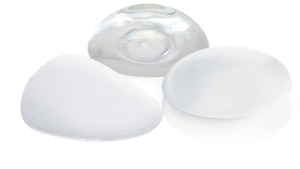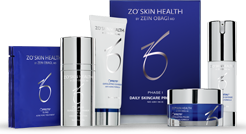Types of Breast Implants
Saline, Silicone or Form Stable Silicone… How do I Choose?
The U.S. Food & Drug Administration (FDA) announced on November 17, 2006 the approval and availability of silicone gel-filled breast implants, ending a 14-year ban on the use of silicone implants for cosmetic breast surgery. Now, all women over 22 years old seeking cosmetic breast augmentation and women seeking breast reconstruction surgery are able to select silicone breast implants. In February, 2013, the FDA approved the first anatomically shaped, highly cohesive, form-stable silicone gel implants (“gummy bear implants”). The availability of these implants has created new options for women considering breast surgery and for those who have had previous surgeries but are seeking new replacements or revision. In November, 2014, the FDA approved more shapes of the form-stable implants.
 Each year, surgical techniques and breast implants themselves are continuously being refined, increasing the safety and reliability of the procedure. With the continued scientific research and development of proven methods, further advancements of breast implant options will be made in stride with the continuing medical education of qualified cosmetic plastic surgeons specializing in breast surgery.
Each year, surgical techniques and breast implants themselves are continuously being refined, increasing the safety and reliability of the procedure. With the continued scientific research and development of proven methods, further advancements of breast implant options will be made in stride with the continuing medical education of qualified cosmetic plastic surgeons specializing in breast surgery.
Breast implants can serve one or more of a number of purposes; breast cancer victims can use breast implants for reconstructive purposes after mastectomy, or women with asymmetrical breasts may use a single breast implant to balance the difference in size. Following pregnancy, many women opt for breast implant surgery to correct reductions in breast size. And of course many breast implant candidates are interested in creating a more flattering contour or size.
It is worth explaining the differences between a shaped, highly cohesive silicone implant, a soft silicone gel-filled implant, and a saline-filled breast implant, The outer shell of both silicone and saline implants is made of a solid silicone material. Solid silicone is widely used in implantable medical devices. Any of the implants can be textured, but all shaped implants must be textured. This prevents the implant from turning within the pocket and may decrease the risk of capsular contracture. Silicone gel implants are filled with silicone gel, which is a semi-solid substance. Saline-filled implants are filled with the same kind of saltwater that is used in I.V. fluids.
Manufacturers
There are currently three companies that manufacture breast implants sold in the United States: Allergan (Natrelle), Mentor, and Sientra. All are quality implants and all are FDA approved. All offer warranties which vary slightly and are different for saline implants vs silicone implants. Each of the three manufacturers who have these implants in the United States had to carry out a trial of these implants for the FDA.
Silicone Implants
Silicone implants have a silicone rubber shell that is filled with a fixed amount of silicone gel. Silicone implants come in smooth or textured shell surface and vary in shape, profile, volume and shell thickness. Silicone gel-filled implants are not adjustable, which is one disadvantage compared to saline implants.
In 1999, a landmark report, undertaken by the Institute of Medicine (IOM) concluded that silicone implants do not cause major health problems such as lupus or rheumatoid arthritis. And while no one can ignore the fact that silicone – and saline – breast implants may cause localized problems for some patients, numerous scientific studies over the years have shown that silicone gel-filled implants are both safe and effective for breast augmentation and reconstruction. In fact, silicone gel breast implants are widely used in 60 countries around the world, including Europe.
In the past decade, a number of independent studies have examined whether silicone gel-filled breast implants are associated with connective tissue disease or cancer. The studies, including a report by the Institute of Medicine and the findings of the FDA, have concluded there is no convincing evidence that breast implants are associated with either of these diseases.
The History of Shaped Implants
In the 1980s, there was a popular teardrop shaped implant developed by Surgitek. Dr. Paul LoVerme used many of these implants, and published a paper on the surgical technique of inserting these implants. The implants had a nice teardrop shape. They were covered with a polyurethane layer outside of the silicone shell, and when you held them in your hand, they felt like they would maintain their shape. When initially implanted, the results were gorgeous; but, soon the implants lost that great shape. The implant shell was not stiff enough to control the shape of the gel within it. Shaped saline implants were also tried but, when implanted, looked round because the saltwater could not maintain the shape. The goal was to create a gel breast implant that could maintain that shape over time and resist breakage. It was clear that the shell alone could not do it. The gel itself would have to be able to hold its own shape.
Cohesive gel differs from standard silicone by being more “cross-linked.” That crosslinking between the molecules of silicone make it a bit thicker and firmer, enabling it to maintain its shape. The term “form-stable” refers to the tendency of these implants to have a constant shape. While the name “gummy bear” implant has been associated with these newer implants, they are not in any way as firm as gummy bear candies.
Once a gel was developed that could hold a shape, it became possible to make a great number of shapes in a particular volume. This gives the surgeon unprecedented control of breast shape, allowing greater possibilities in creating a shape that is most attractive for a woman, or to correct pre-existing deformities of a woman’s own breast shape. Each of the three manufacturers who have these implants in the United States had to carry out a trial of these implants for the FDA.
However, remember this caveat: Great breast augmentation results come from the surgeon, not the breast implant.
While Cohesive Implants are excellent and have certain advantages, a great breast augmentation is about the surgeon and not the implant. No breast implant guarantees a great shape, freedom from rippling, avoidance of hardening, or any other problem that can occur. Gorgeous breasts are created through outstanding surgery. While understanding that the inherent advantages of these implants may help you achieve a better result, do not allow just the enthusiasm around them alone to sway you. Satisfied patients with cohesive gel implants have learned the advantages and disadvantages of these implants and decided that they are right for them.
What is Saline?
Saline is saltwater-based solution used to fill breast implants. Enclosed by an outer silicone shell, saline implants can often be an excellent alternative for patients who are not qualified and/or do not wish to receive silicone gel-filled implants.
Advantages and Disadvantages of Saline vs. Silicone
Officially approved by the Food and Drug Administration (FDA) in 2000, saline implants have a number of advantages and disadvantages in comparison to silicone implants, which gained FDA approval in 2006. Though both types of implants share the risk of rupture, the saltwater solution inside saline implants is harmlessly absorbed by the body in the event of a leak or break. In addition to this benefit, the volume of saline implants can be modified (within a certain range) during augmentation surgery, depending on the patient’s unique needs and desires.
Despite these advantages, many women – particularly those who have a slender figure – tend to find that saline implants do not create as natural a look and/or feel as their silicone gel counterparts. Furthermore, saline implants are still susceptible to several of the same risks as silicone implants, including wrinkles/ripples, capsular contracture, discomfort, infection, and even potential nerve damage. Breast implants – whether saline or silicone – are not permanent devices and may eventually need to be replaced.
Benefits of Silicone Implants
Benefits of Cohesive Gel Breast Implants
Disadvantages and Risks of Cohesive Gel Breast Implants
Benefits of Saline Implants
Dr. LoVerme will review all of these options, as well as your desires and the surgical procedure, when you come in for your consultation. He will give you his expert opinion as to the best plan and implant for you. To schedule an appointment, please contact us today.








